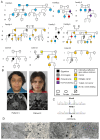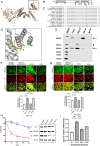Reassessing the role of the p.(Arg304Gln) missense AIP variant in pituitary tumorigenesis
- PMID: 40070360
- PMCID: PMC11962913
- DOI: 10.1093/ejendo/lvaf044
Reassessing the role of the p.(Arg304Gln) missense AIP variant in pituitary tumorigenesis
Abstract
Objective: Heterozygous germline loss-of-function variants in AIP are associated with young-onset growth hormone and/or prolactin-secreting pituitary tumours. However, the pathogenic role of the c.911G > A; p.(Arg304Gln) (R304Q) AIP variant has been controversial. Recent data from public exome/genome databases show this variant is not infrequent. The objective of this work was to reassess the pathogenicity of R304Q based on clinical, genomic, and functional assay data.
Design: Data were collected on published R304Q pituitary neuroendocrine tumour cases and from International Familial Isolated Pituitary Adenoma Consortium R304Q cases (n = 38, R304Q cohort). Clinical features, population cohort frequency, computational analyses, prediction models, presence of loss-of-heterozygosity, and in vitro/in vivo functional studies were assessed and compared with data from pathogenic/likely pathogenic AIP variant patients (AIPmut cohort, n = 184).
Results: Of 38 R304Q patients, 61% (23/38) had growth hormone excess, in contrast to 80% of AIPmut cohort (147/184, P < .001). R304Q cohort was older at disease onset and diagnosis than the AIPmut cohort (median [quartiles] onset: 25 y [16-35] vs 16 y [14-23], P < .001; median [quartiles] diagnosis: 36 y [24-44] vs 21 y [15-29], P < .001). R304Q is present in gnomADv2.1 (0.31%) and UK Biobank (0.16%), including three persons with homozygous R304Q. No loss-of-heterozygosity was detected in four R304Q pituitary neuroendocrine tumour samples. In silico predictions and experimental data were conflicting.
Conclusions: Evidence suggests that R304Q is not pathogenic for pituitary neuroendocrine tumour. We recommend changing this variant classification to likely benign and do not recommend pre-symptomatic genetic testing of family members or follow-up of already identified unaffected individuals with the R304Q variant.
Keywords: AIP; FIPA; acromegaly; genetic variant; gigantism; prolactinoma.
© The Author(s) 2025. Published by Oxford University Press on behalf of European Society of Endocrinology.
Conflict of interest statement
Conflict of interest: A.R.-O. is now a full-time employee at Ipsen Bioscience (Boston, USA) and he holds stocks from the company.
Figures



References
-
- Hernández-Ramírez LC. The role of the aryl hydrocarbon receptor interacting protein in pituitary tumorigenesis. In: Stratakis CA, ed. Gigantism and Acromegaly: Academic Press; 2021:89–126.
MeSH terms
Substances
Grants and funding
LinkOut - more resources
Full Text Sources
Medical
Miscellaneous

